In my ongoing work as a land healer, I find that I regularly need a retreat from my battered bruised landscape. Why? Because this work is really difficult. Lately, it seems more so–we have large swaths of forests where I live that are being cut down to make way for more fields, we continue to face threats of logging of so-called ‘protected’ lands here locally, and well, it has just been a few hard years. I find myself growing weary at work that never seems to be done and is in fact increasing each year–me traveling across these beautiful, ancient Allegheny mountains, always finding the ruined places, the damaged places, the places harmed by human hands. Doing what I can, in my own small ways, to do the work of healing and repair. This work is good, it is right, but it is exhausting and isolating. I don’t know anyone else in my region who is dedicated to this kind of work as a primary spiritual path. Lately, I’ve been feeling just bone-deep weariness and sadness because everywhere I look where I live, it feels like things are all going in the wrong direction. More deforestation, more human demands on the land, more toxic spills and waste, more fracking wells, more coal-fired plants, and more and more pain on this landscape. Adding that to the increasing effects of climate change, and well, it is hard to hold that all in your hands and to keep saying to your land, just hold on, a bit longer.
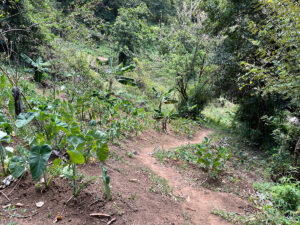
Speaking of hope, when I’ve spoken on this blog about a vision for the future, that vision often centers on fundamentally changing the basic relationships between humans and nature: moving from relationships that exploit and extract to those that nurture, tend, and reciprocate with the living earth. Where the land and her peoples live in harmony and balance; living slowly, richly, and locally; focusing on how to transition from what we have now to something much better, something that gives space for all life to thrive. I can see it in my mind’s eye, and when things get difficult for the land and I, we focus on that vision–that bright future. And I remind the land that so many of us who practice permaculture, herbalism, druidry, natural building, earth skills, and other ancestral connections are working to bring this forth. My land and I share this vision, we often talk about it and this vision is what keeps us going. In today’s post, I want to share the story of a journey that I was able to take to land that already enacts that vision.
Because of this bone-deep weariness about the present and future, I knew I needed a retreat. In late February, I went to a friend’s house to visit and help her with her book project. She told me she was house-sitting at a retreat center in the Caribbean, in a tiny island nation, St. Vincent and the Grenadines, and she invited me to join her on the retreat. The timing was perfect, since I am on sabbatical right now and working on a book full-time, it seemed like a wonderful opportunity. Of course, I always have to weigh these kinds of opportunities with the environmental impact. Air travel emits a lot of CO2 and I try to avoid it when possible, although in this case, if I was to go, I had to fly there. Thus, I always pay to offset my emissions, in addition to working to live my life as sustainably as possible and sink as much carbon as I am able to do.

The land of St. Vincent and the Grenadines was deeply healing and nurturing in ways I did not expect. The land was, as expected, tropical, warm with breezes blowing, and beautiful to see. But it was not a major tourist destination, so we got to simply experience the local culture. Because of where we were staying, we were able to meet a number of local farmers and learn more about the Vincentian’s relationship with their land. And what I experienced filled my heart with joy–the people here really cared for their land, they honored their land, and they tended the land in loving ways. What I felt radiating from the land when I first arrived on the island was because of this reciprocation: I felt this deeply healing and nurturing energy from the land because that land was deeply honored and nurtured by her people. This brought me such joy: my own vision for the lands of the Appalachian mountains was literally being enacted there before my eyes: a whole culture of people who deeply honored the land and lived in harmony with that land. Seeing this reciprocal, care-based relationship is what I’ve been hoping can happen everywhere–and here it was, happening in a beautiful way.
Many of the food-growing areas and farms are high up in the mountains, which creates a really interesting set of circumstances. The land is very mountainous, and most of the people live in the valley areas, areas that are accessible by roads and cars. But they are on a tropical island, so bringing in external food is expensive–thus, people grow as much of the food as they can themselves. In a year-round tropical climate, they are always growing and harvesting some fresh produce, often in beautiful food forests. In the valleys where people live, people tend small gardens and may have a lot of edible fruits growing as well as limited livestock (cows, goats, and chickens). But the bulk of the produce that is eaten comes from mountain farms. These farms, situated in the rich volcanic soil, are only accessible on foot and may require quite a hike up and back down again.
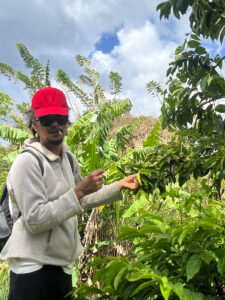
My friend Sue, who is a fellow herbalist and lover of the earth, and I spent a good number of days getting to know the local plants and the local people who tended those plants. For example, we had a wonderful opportunity to visit Hope Estate Cannabis farm, a wonderful farm of good people growing good medicine. We started at the bottom of the mountain, and then to get to the farm, we hiked about an hour straight up into the mountain on a rocky, mountain path. There would have never been a way for a fossil-fuel-powered vehicle to get up there–whatever we wanted to bring, we carried on our backs. Our guide, Isong, even carried 3 gallons of water right up the mountain with us. I was thinking to myself, what a wonderful commute to work, a hike up into the mountains each day, for work.
As I was having this magical experience of visiting the mountain farm, I was thinking to myself how my own culture would manage this kind of circumstance. I could never see anyone in the USA being willing to do this hike each day, and leaving their fossil fuel-powered vehicles and tools behind. They’d rip out the trees and plow up the soil, they’d use heavy machinery to create a road right up into the mountain in the most destructive way possible. And then, the land would be managed with the aid of fossil fuels and machines, destroying the soil web and contributing to the ongoing challenges. But not the islanders–they just used their own two feet, carrying themselves up the mountain, and returning with 50+ lbs of food carried on their backs, which is then sold locally at stands or even on the porch of their home. Many people did this either part-time or full-time–you always saw men walking in and out of the mountains, carrying a machete and a bag of something on their backs, their faces smiling as they made their way back to the village homes.
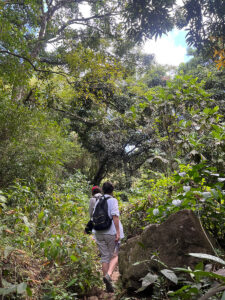
On our journey up into the mountains to Hope Estate Cannabis farm, we not only learned about how they grow sacred medicine is grown, but also about a number of medicinal plants and edible foods. What I came to understand was that this land was deeply tended–even on public lands–and people were everywhere in these wild mountains supporting an extensive food forest network. Our guide up the mountain, Isong, told us that he lived in the mountains for four years, never coming down, just eating off the fruits of the land. He had much wisdom to share about plants and relationships with the land. He explained how people would tend all of the lands up in the mountains–replanting, pruning, scattering seeds, tending small plots, and so on. He also had much philosophy to share about living in this way and how it brought him into a deeper relationship with himself, the land, and the broader cosmos. I told him I wish I could go into our mountains and live for four years, but it was illegal where I lived and that, at present, our land is not tended in such rich ways.
From these wonderful people, Sue and I learned some of the most powerful medicines of the land. We learned of the uses of Cannabis roots (which the farmers gifted us) as a tonic for health, and wellness, and also to support asthmatics. We learned how to harvest cacao pods and enjoy the fruit from the beans before the seeds are made into the richest chocolate. We learned of the Tiki Thyme, Ball herb, Blue Vervain, Leaf of life, Bitter Mellon, Lemongrass, and leaves of the Soursup tree, among other sacred plants and their healing medicine. We learned of the seasons for various fruits and flowers on the land and always had our bellies full of some new tasty delight. When we returned from the mountain, we spent days making herbal medicines (I’ll share in a separate post about this) using all of the ingredients there from the land.

The local food, of course, reflects this amazing landscape, with people eating locally and in season. Most of the food is cooked in traditional ways–while we were up in the mountains, we enjoyed a lovely soup with all local vegetables from the mountain. The soup had eddoe roots, onions, coconut milk, coconut dumplings, and fresh greens. It was deeply healing and nourishing, served in a gourd bowl.
The other thing that was notable was the genuine humility, friendliness and goodwill of those who tended the land. These were people who were so respectful, so kind, and so honest.They were willing to share their wisdom and the fruits of their labor. They had time to teach. They were eager and willing to have us learn from them, and appreciate the work they were doing. It makes me realize that part of the equation of healing and balancing the land goes back to that not only do we need to change our relationships with the land around us, but also with each other. To be kind, generous, and open–that same relationship with the land needs to be present in each of us.
As I was nearing the end of my time and visit to St. Vincnet, the power and importance of this experience really struck me. What I mean is this: for so long, I had been envisioning something that looked just like what was happening here as one of the best possible futures for the Allegheny mountains. I had been putting that vision out as a magical act for some time. Part of this was because I had been reading about land tending and reciprocal relationships in terms of this land and related land’s history, thinking about what the Americas must have been like prior to colonialization. I knew places like this must exist, where people are able to enter into such a beautiful reciprocal relationship with their land. Due to my work, I end up visiting many different places around the world. And while I’ve seen this kind of activity in really beautiful ways in isolated pockets (like at Dancing Rabbit ecovillage), I’ve never seen this kind of land tending on a society-wide scale. But it exists, here and now, and it is beautiful. It is more than I could have envisioned or imagined. I will need more time to process this–one of the things I’ve been thinking about is how to have more than a vision, but have a plan to get there. What can I do? What can others do? This experience helped me see some potential avenues. I’m not ready to share on that yet, but stay tuned.
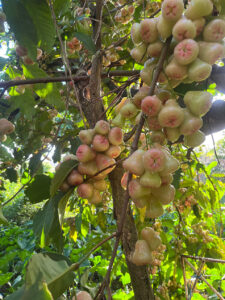
When I returned to my battered, bruised land here in Western Pennsylvania, things looked so different. My drive home revealed even more deforestation, the regular coal-fired power plants spewing their toxins, and people not recognizing the spirit of my own beautiful, ancient mountains. People went about their hurried and busy lives, not paying attention to the beauty of nature around them. But, everywhere I looked, I could see the possibilities unfolding, that bright future is not yet written, that vision that I continue to hold–in my mind, heart, and spirit–stronger than ever before.
The first thing I did when I returned to my own land was that I went to the sacred grove on my land, my grove of renewal. This was a damaged place that had been logged and had multiple toxic burn pits–cleaned up the burn pits and planted a range of native, woodland medicinal species that grow more endangered and threatened by the year. It is in this place that I do my deepest visioning and healing work, it is this place where we work to radiate that vision outward. And so, I told the story to the trees, to the mountain, and to all of us here who continue to hope and dream. I sat in a sacred grove on this land, and I shared it all–not just the story, but the vision, the energy, the experience with the Allegheny mountains. We cried together, knowing that if it could happen in one place, it could happen in others. This experience gave us a tremendous gift–the gift of hope.
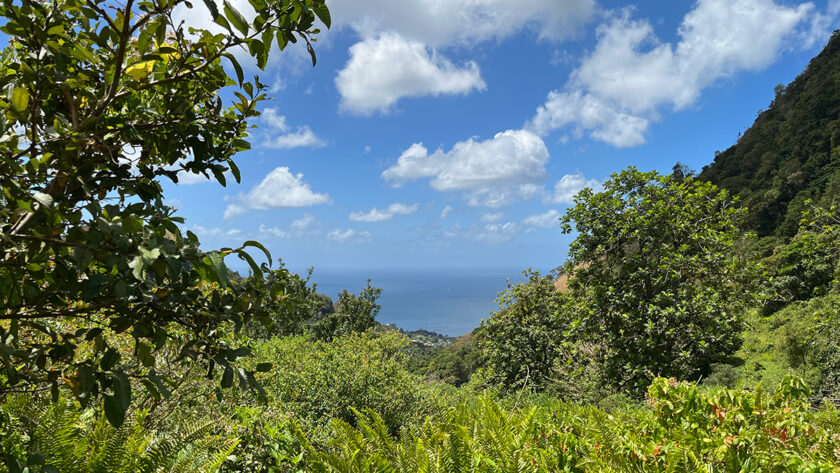



Awen…..I am a Druid who is attempting to create a permaculture environment on my 1/2 acre property . I am 74 years old and of limited energy and resources but I am clinging to my Vision and slowly moving forward . I just pulled cards from my Druid Animal Oracle deck asking for guidance around this Impulse and it was encouraging .It spoke of Wealth ( Spiritual ) , Healing, Transformation, and Guidance and Loyalty . All are attributes that I hope I can access and share thru my Vision here at Alfheim ( this is what I am calling my home/land ) . Your essay was quite timely and of a piece of what I need to believe in and foster . Thank You for your work, efforts and Spiritual Journey, and for Sharing these Ideals. Much Love and Hope . Druid Errant, OwlWing StarStone. AWEN
Hello OwlWing, this is awesome to hear. We have 5 acres here and are doing the same. Every little bit counts–please share more of your vision and your lovely space! Blessings, Dana
Thank you for this wonderful article and for your vision. People are missing so much of life when they are disconnected from nature. If more of us could work with the land as you do, I think we can manifest this type of reciprocal relationship with the land in the U.S. I’m trying to make this a priority for myself. Blessings!
Hi Leslie,
Thanks so much for sharing! I think that’s it–making things a priority. I’ve had to make a lot of life choices that ended up being on the land here, and I feel good about those choices. The more of us that return to the land to heal and nurture, the better. I’m glad to hear you are on this path as well! Blessings!
Hi Dana! I’ve been working on healing the land at my grandparents house here in northeast Arkansas. I’ve followed you for a few years and share a similar vision. I talk to the trees, they have so many stories. I am working on planting natives but it is a slow, gradual process for a lone druid. I think there are many of us that share this vision but due to deep societal conditioning, we stay scattered and staunchly clinging to “independence”. So many of my gardener/farmer friends do this sacred work but in the parameters of their family unit or just alone. As you said, there is hope though. Hope for change, hope for growth, and hope for community. <3
Hi Samantha,
Thank you for sharing. I do think there are more of us out there that share this vision, and it is time for us all to start talking and sharing. Removing the conditioning. Thinking about our own inter-relationships with everyone and all life. All of this work is slow work. Thank YOU for doing this work on behalf of the land. Your land loves you and is so happy you are there. Blessings!
It is depressing to see the damage being done to the environment, but if lucky enough to own some land and preserve it then count your blessings. We own a small woodland in the uk and plan to care for it for as long as we can. There are many people who are homeless and jobless who cannot even hope to be able to do anything about the destruction all around them because they are just trying to survive. Stay connected to nature and as I said before, when feeling hopeless just count your blessings that you are able to when many others can’t.
Hi Raven,
It is beyond depressing…I feel like every time I look out on my landscape, we are going in the wrong direction. It’s a huge weight to carry when you feel alone. Thanks for putting things into perspective…glad to hear about the woodland in the UK you are protecting and caring for. Would love to hear more about it!
Reciprocity, stewardship, reverence, are not taught or valued in a consumer society. However working with the land, even a small plot, it is clear and present that what we put in becomes the soul of the land… the organic matter we put into the soil, the worms and microbes, the tending the weeding our energy our intention our gratitude, all are part of that. It starts with the children and a flower pot.
Hi Navenka,
It does start with children and a flower pot! And maybe, a lot of us consciously choosing to move away from the ideals and practices of consumer society and back into the open arms of nature :). Blessings and thank you for your comment!
thank you for sharing this aspect of your life work. I think many of us are afraid to share when we become discouraged or burnt out in case we seem weak to others, or that the work we do is hopeless. I appreciate the honesty of your account and also how you show the necessity of rest for renewal of the spirit…and the inspiration we can draw from outside of our own sphere. I also was intrigued by cannabis root medicine and intend to do some more research on this.
Hi Ruth,
Thank you for sharing and reading. I think its important to be honest about this work. Land healing is not all puppies and rainbows, lol. In fact, its some of the hardest and most brutal work you can do–staring into the face of what your own race, your community, does to other life. The utter destruction that a single human with a fossil fueled machine is capable of wielding, the amount of death….yeah. We need to heal. And we need to talk about this work.
The cannabis root medicine was so fascinating. I had it as tea when I was down there. It is not psychoactive, but it is deeply restorative, having a very delicious taste (very earthy, kind of reminding me of burdock root), very nutritive. I hope to be able to get it sometime again!
Thank you for the work you continue to do on behalf of the land, Dana. A friend sent me a link to an interesting organization called Radical Joy for Hard Times that has a worldwide mission to bring beauty to damaged places. https://radicaljoy.org I like how the website mentions that no matter how damaged a place is it still has meaning and worth and beauty that we can honor even through our grief.
Hi Suzanne,
WOW, this is just fabulous! I will check out this organization more. This is something I could definitely use!
What a beautiful experience! Thank you for sharing this story!
I am wondering if you have posts about dealing with the frustration and weariness of being a land healer?
My husband and I moved to the Warner Mountains in southern Oregon 2 years ago. Shortly after that I found your blog. 🙏 I had been experiencing stagnant spirituality for a while but your voice sang to me and I’ve been doing my best to study Druidry and land healing and permaculture and natural building, etc. ever since. My land has been over-grazed. It’s high desert and for at least a century or more the land has suffered at the hands of people trying to “master” it with force and fierceness of will.
I’m still learning all that once was here on my 4 acres… When the Modoc and other Originals Peoples lived here.
I find myself frozen sometimes. Frozen in fear of all that I don’t know and need to learn. Frozen from being overwhelmed by the level of work involved. Frozen by over contemplation of the conservative American community I live in that believes their way is the only way and I talk & look funny.
Are there old posts you can direct me to that focus on processing this, dealing with & healing through these emotions and stuck places? I am only at the beginning, and have not yet begun planting. I have no grove to go to. Yet. 🙏 Thank you.
Hi Kathey,
Thanks for sharing your story! You are not alone! Can I ask a few questions: Are you talking about emotional processing for yourself? for others? for the land?
I have a book coming out on land healing in 2024 with Red Feather (subscribe to my blog and/or newsletter to stay updated on it!) But… It sounds like maybe I need to write a few more posts. I have a lot of material in there that isn’t on the blog on this topic. But in the meantime… I’m happy to write some more here and share (maybe I’ll write more on this, because I am similar circumstances here–I am blown away by how rural, conservative people treat the land, how to share how you are being different, how ot reach out to the land, etc. Always more to write).
Here are some things that might help:
Have you tried co-setting intentions with your land? That can be a wonderful first step: https://thedruidsgarden.com/2022/03/27/druidry-for-the-21st-century-setting-and-co-creating-intentions-with-nature/
Land healing and processing your own emotions: https://thedruidsgarden.com/2016/04/10/a-druids-primer-on-land-healing-part-vii-self-care-and-land-healing/
On the work of repair: https://thedruidsgarden.com/2016/03/27/a-druids-primer-for-land-healing-part-v-the-magic-of-witnessing-apology-and-connection/
Physical land healing work: https://thedruidsgarden.com/2020/03/29/physical-land-healing-how-do-i-know-what-to-do/
These are a few that come to mind, but please share a bit more details and I can help further, write something, or we can keep talking!
Your story about our life changing adventures in the beautiful St. Vincent and the Grenadines island brought me to tears. The medicinal plants, array of exotic fruits and simple vegetables that surrounded us there gave a sense of pure nurturing, as if being fed nutritionally right to the soul level. The farmers and plant tenders vibrated in harmony with their land, elevating the food and medicine to a higher level than I’ve ever experienced before. Every moment there offered a profound opportunity to rejoice with the plant energy in The Spirit of the Valley on St. Vincent.
Thank you, Sue! It was a wonderful experience to have with you! 🙂
You gave me the idea that visions may be non local. That holding the vision may enable it to materialize in another location. That this heart filled creation is becoming real in places I have not visited yet. I was unaware of your efforts until my lovely friend Michele who also holds this vision and creates in her mountain space shared your blog. Oh my and now my heart is lighter and at 75 this is a grand feeling from which to envision and create.
Hi Bonnie, Thank you for sharing! Hold that vision! Bring it into the world anyway you can! 🙂
Thank you for this shining ray of hope and for reminding me to hold this vision as well!
Blessings to you, Annette! Hold the vision strong!
much love and thank you for sharing the good work
Dana, I stumbled onto your diary looking for information on building a cob oven, but I wept with joy reading this post. The work is hard and slow, but there are more of us than you (or I) know. My four acres of abused, degraded hilltop in the Virginia Piedmont are now forming topsoil. After ten years the chestnut trees are bearing, along with oak and hickory, tree-peas, cherries, blueberries, and wild strawberry, and the squirrels dance along the trunks of the fallen every morning. These sanctuaries provide islands where life can sink its roots before bursting out again in glory.
Blessings to you, Cynndara and for the work that you do! The land loves you for it :).
Amen SiStar! There are more of us than we know! Quietly doing the work, which feels not like work because it is our joy!